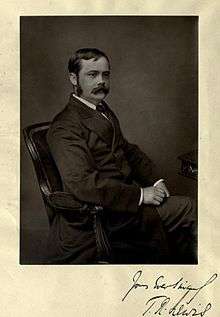Timothy Richards Lewis

Timothy Richards Lewis (31 October 1841 – 7 May 1886) was a Welsh surgeon and pathologist who worked in India on several aspects of tropical medicine. He worked during the early period when the role of pathogenic organisms in disease were beginning to triump over the older miasma theory. He was one of the first to identify the role of nematode worms in filariasis. His studies include those on cholera, leprosy, trypanosoma, and fungal infections.
Lewis was born at Llanboidy, Carmathenshire to William Lewis and Britania nee Richards and he grew up on the family farm at Pembrokeshire. After studying at Narberth National School the grammar school run by Joseph and William Edward Morris he apprenticed to a Narberth chemist. He moved to London when he was nineteen and worked as a chemist in Streatham and later at the German Hospital where he picked up the German language. He also attended lectures at the University College London, received a Fellowes silver medal in 1866 and qualified from Aberdeen University in 1867. In 1868 he joined the army service at Netley and rose to the position of a surgeon-major. He worked for three months at Munich with Max von Pettenkofer and then was posted to Calcutta in 1869. In Calcutta he worked with David Douglas Cunningham. Pettenkofer had suggested that soil conditions helped in cholera outbreaks while Ernst Hallier of Jena had suggested that it was caused by a fungus. Lewis tried to examine these hypotheses making studies of meteorological conditions and examining the stools of infected patients. A study with Cunningham was made on fungal skin infections.[1] While making studies of chyluria, he noticed worms in the urine of a patient which was later found to be filaria and were independently discovered and described by Joseph Bancroft.[2][3][4] Lewis examined microscopic organisms in the blood of birds and mammals,[5] and named several species of microbes including a trypanosome, Trypanosoma lewisi, from a rat.[6][7] He married Emily Frances nee Brown on 8 October 1879. In 1883 he returned to England and worked as a Professor of Pathology at Netley. In 1885 he served as honorary secretary of a committee to study Koch's discovery of cholera. He died on 7 May 1886 of pneumonia, suspected to have been contracted in a laboratory accident.[8]
He is one of twenty three whose names are included in a frieze at the entrance of the London School of Hygiene and Tropical Medicine.[9]
Publications
- (1888) Physiological and pathological researches; being a reprint of the principal scientific writings of the late T. R. Lewis. In memoriam. Arranged and ed. by Sir William Aitken, G. E. Dobson, and A. E. Brown
- Lewis, T.R. and D.D. Cunningham (1877) Leprosy in India
- Lewis, T.R. and D.D. Cunningham (1877) The 'Oriental Sore,' as observed in India.
- Lewis, T.R. and D.D. Cunningham (1875) The soil in its relationto disease. A report of observations.
- Lewis, T.R. (1874) The pathological significance of nematode haematozoa. Calcutta: Government Press.
- Lewis, T.R. and D.D. Cunningham (1874) A report of microscopical and physiological researches into the nature of the agent or agents producing cholera.
- Lewis, T.R. (1870) A report on the microscopic objects found in Cholera evacuations, &c.
References
- ↑ Lewis, T.R.; Cunningham, D.D. (1875). The Fungus-disease of India: A report of observations. Calcutta: Government Press.
- ↑ Manson, Patrick (1879). "On the development of Filaria sanguinis hominis, and on the mosquito considered as a nurse". Journal of the Linnean Society. 14: 304–311.
- ↑ Lewis, T.R. (1878). "Remarks regarding the haematozoa found in the stomach of Culex mosquito". Proceedings of the Asiatic Society of Bengal: 89–93.
- ↑ Cox, F. E. G. (2002-10-01). "History of Human Parasitology". Clinical Microbiology Reviews. 15 (4): 595–612. doi:10.1128/CMR.15.4.595-612.2002. ISSN 0893-8512. PMC 126866
 . PMID 12364371.
. PMID 12364371. - ↑ Lewis, Timothy Richards (1879). The microscopic organisms found in the blood of man and animals, and their relation to disease. Calcutta: Government Press.
- ↑ Lewis, Timothy Richards (1879). "Memoirs: Flagellated Organisms in the Blood of Healthy Rats". Journal of Cell Science. s2: 109–114.
- ↑ Lewis, Timothy Richards (1884). "Memoirs: Further Observations on Flagellated Organisms in the Blood of Animals". Journal of Cell Science. s2-24: 357–369.
- ↑ "Dr. Timothy Richards Lewis (1841–1886)". Nature. 148 (3758): 562. 1941. doi:10.1038/148562a0.
- ↑ "Behind the Frieze". London School of Hygiene and Tropical Medicine. Retrieved 11 September 2016.
External links
- Netley Military Cemetery
- Behind the Frieze - Timothy Richards Lewis (1841-1886)
- Dictionary of Welsh Biography